CES 2014: Surviving the vehicle tech of the future
- Published
Mark Ward tests the Navia robot shuttle
Writing about technology must be one of the safest trades it is possible to pursue.
Until today.
I'm about to confront the future head on. I'm standing at the side of a test track while a robot shuttle the size of a small bus bears down on me. In a moment I'm going to step out in front of it to see if it runs me over.
As a kid I was told never to step in front of a moving vehicle and here I am about to do just that. I'm nervous, worried.
I take a step, the shuttle's electric engines whirring louder all the time and... I'm fine. It stopped well short thanks to the four laser scanners it uses to spot what is in front of it.
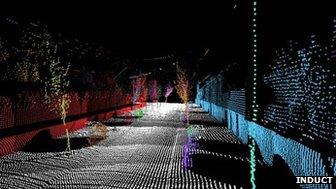
Navia uses laser-based Lidar technology to create a map of its surroundings
No harm done, but my heart is beating faster.
Congestion-buster
Called Navia, the robot shuttle was built by the French company Induct, founded by Max Lefevre and his father. Both are experienced racing car drivers, so the shuttle is a real departure for them.
"I love driving but I hate the traffic," says Mr Lefevre, adding that vehicles such as the shuttle - which holds up to eight passengers - might be a way to fix that problem.
"If you want to reduce congestion you need to reduce the number of cars; you need solutions for that problem," he says.
Currently, autonomous vehicles cannot run on Europe's domestic roads, so the Navia is being refined through tests on university campuses and large businesses.
It is also being put through its paces on a test track at the Consumer Electronics Show (CES) where I had my close encounter with it.
Car tech is a big theme at the show and many motor manufacturers are showing off concepts and vehicles that exhibit varying degrees of autonomy and other futuristic innovations.
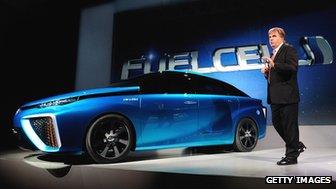
Toyota's fuel cell concept vehicle uses hydrogen to generate electricity and emits water vapour
For instance, Toyota showed off a car powered by a hydrogen fuel cell that it plans to start selling in the US in 2015.
Autos Alliance
Beyond the show floor at Las Vegas there is plenty of interest in robot cars and how their sensors can be refined to make them safe to mix with vehicles driven by humans.
Of these, probably the best known is Google's fleet of 24 robot Lexus SUVs (sports utility vehicles) that have racked up about 500,000 miles of safe, unassisted driving.
And it was Google that made the headlines at CES this year when it announced a plan for an Open Automotive Alliance that will develop a standard way for its Android software to work with in-car computers made by Audi, GM, Hyundai and Honda.
A driverless car reverses into a parking space
Chip-maker Nvidia is also a partner.
Google is not alone in trying to woo car makers. Apple has already inked deals with Honda and Hyundai on ways to get its iOS operating system into cars.
At first glance there may not seem to be much connection between an autonomous vehicle and the in-car entertainment made possible by the Google and Apple deals.
But, said Gartner analyst Thilo Koslowski, there's a deep connection between the two.
"Once you have a car that you do not have to pay attention to any more then it becomes a rolling sofa," he said. "That will mean you need content and a lot of that will be digital and come from clouds."
General Motors shows off its 4G data connection technology
Because of that, he said, deals done with car makers will assume much greater importance as vehicles get more capable.
Ultrasonic sensors
Demonstrations arranged by Audi, General Motors, Ford, Bosch and others at CES show just how smart cars are getting.
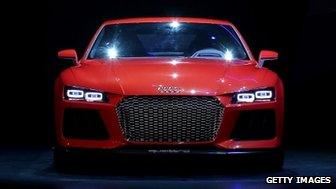
A record nine major car manufacturers are exhibiting their vehicles at CES this year
At the show French firm Valeo showed off a valet parking concept.
The idea, said spokesman Harald Barth, is that the car parks itself after the owner has jumped out at the entrance of a car lot or multi-storey car park. It finds a space and, guided by a laser scanner and ultrasonic sensors, slots itself in and turns off.
Then, he said, when you are ready to go home you let it know via a smartphone and it drives to meet you at the exit so you can pilot it home.
"We want it to be autonomous and not rely on any special infrastructure," said Mr Barth.
He added that there might come a day when a shopping trip into town was much more pleasant because once its passengers have disembarked, the car could go off and park itself.
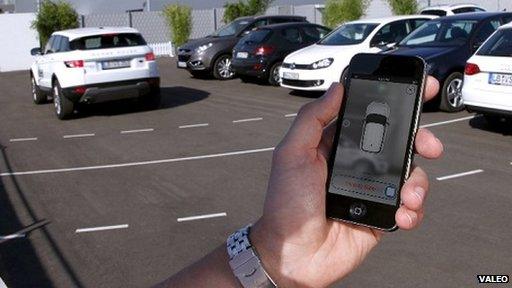
Valeo allows a car's owner to summon it via a smartphone app
"However," he said, "that will only come about in small steps. Initially the self-parking will only be in certified parking areas, dedicated car parks and multi-storey facilities."
'Dog food'
There's no doubt that humans are steadily being squeezed out of the driving seat as cars get better at handling themselves.
But there's still a long way to go. Engineers developing autonomous vehicles have described the technology as "dog food" - by which they mean it is not fit for human consumption.
Governments have certainly been reluctant to change rules and regulations to allow robot cars, of any degree of autonomy, on the roads.
"Governments need to understand what drivers are looking for and come up with guidelines of how to make it work," says Mr Koslowski.
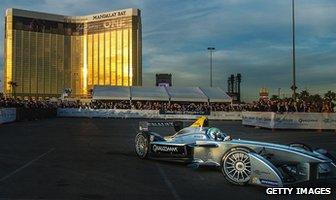
Formula E brought its electric racing car to CES. The motor sport plans to showcase self-drive tech in the future
The car, he says, has the potential to become the "ultimate mobile device", and they are getting smarter all the time.
Perhaps the greatest change those robot vehicles will wreak on society will not be the fact that there will be a lot less of them or that people never have to learn to drive.
Maybe the bigger change will be that far fewer people are run over and killed.
If only 10% of cars on US roads were robotic that would mean about 1,000 fewer deaths, suggests a 2013 study by the Eno Centre for Transportation.
As the number of robot cars rises, the number of fatalities, and car crashes, falls.
Maybe that small step on to the test track in front of the shuttle was the start of another giant leap that we are all about take.